A yoga inspired boutique in Sedona, Arizona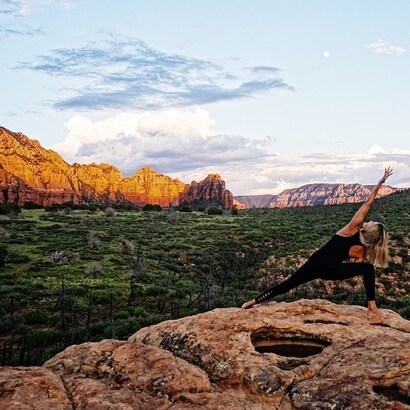 Be sure to check out Yoga Blessing in the Bashes shopping center West Sedona. This store has everything you need for Yoga and much more. The owners Julie Wallace and Kenyon Morton will make your shopping experience effortless! 162 Coffee Pot Drive Sedona AZ 86336. tel:9282821279 Yoga Blessings is a yoga inspired boutique located in the magnificent Sedona, Arizona. We offer a large, beautiful selection of yoga and athleisure wear, yoga mats, props and accessories. We are proud to carry the highest quality, well-known and reputable brands, an inviting and peaceful shopping experience, and a customer service perspective that encourages feeling comfortable and attractive about what you wear on and off the mat.
0 Comments
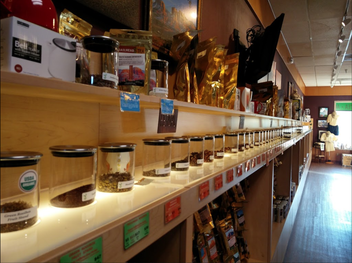 Trailhead Tea is a locally owned, full-leaf tea merchant located in downtown Sedona, Arizona. They offer up to 150 tea and tisane selections from around the world including Taiwan, China, Japan, India, Sri Lanka, South Africa, and soon from Thailand, Nepal, Vietnam, and Kenya. You can visit the store to learn about the varieties of green, black, white, oolong, rooibos, mate, chai and herbal teas. They offer modest price blends for shoppers new to high quality teas, but connoisseurs will be surprised with our premium, rare and “tribute” teas. These brew up to make a light, refreshing and healthful drink that is popular both hot and iced. Every day, they have some samples for shoppers who stop by. If you are really stuck picking a new flavor, we offer to-order tasters of many items in our store so you can learn what you like. Or... stop by the tea bar and enjoy a tea to-go of any selection in the entire store. Trailhead Tea 251 State Route 179, Suite B9, Sedona, AZ 86336-6179 info@TrailheadTea.com 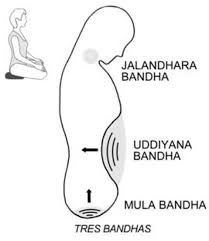 Yin and Yang Side of Bandhas I wanted to discuss the Yin and Yang side of bandhas; very beneficial not just to our yoga practice, but our everyday life. This is especially important for people with lower back issues. So, you may wonder why talk about bandhas? What are bandhas? They are body locks in key points in our bodies where prana (breath), our life force and energy are present. Prana is the upward lifting energy in our spine. Apana is descending energy in our spine. This actually prompts our lungs to breath as two energies flow together. This stimulates the nervous systems and optimizes circulation throughout our bodies. Bandhas are contracted by specific muscles groups. When we engage the bandhas it directs the prana into the nadis. Nadis are pathways which translates to “little rivers.” Some ancient text, Shiva-Samhita claim there are 350,000 nadis. Upansihad tells us they are countless, especially in our Yin poses where we slow down the breath and relax into the pose. We know the importance in our active Vinyasa practice where the bandhas and breath are key to our practice. However in Yin where we hold the poses for long periods of time, it is equally important, in a different way. Let me explain: As we fold forward, we can engage (perineum) Mula Bandha and Uddiyana (abdomen) upward motion. This brings the pose to new level,as you become actively engage with the breath and bandhas. Bandhas exercise I invite you to try this while inhaling on four second count breath. Engage your root lock and then relax it while you exhale slowly on a four count breath. Keep this count/breath active as you hold your poses in Yin. In Yang classes the poses move more quickly and the bandhas are continuously engaged. The third lock lock is Jalandhara (neck/chin). Paul Grilley states, “Keep the Glottis open when performing jalandhara bandha as we fill our lungs with air.” We want to maintain a sense: as if we are sipping small amounts of air, however we are not actually inhaling deeper. The breath is a normal rhythm. The general feeling is that jalandhara bandha will control the flow of breath/prana in the neck area. See if you can visualize Apana as the breathing of downward rooting energy. Apana is most easily felt during exhalation. Close your eyes and feel the energy as you inhale Prana up your spine. Hold the breath for a second or two. On the exhale visualize the Apana energy coming down to the base of your spine. Remember with each inhale to engage all three bandhas, hold, then release as the breath travels down your spine. Uddiyana Bandha The Uddiyana is praised above all others in most circles. Pattabhi Jois defines the Uddiyana Bandha as "Lifting the core muscles four inches below the navel". To engage this bandha we contract the abdomen above and below the navel and toward the back”. In active Yang practice the lower abdomen should be drawn in and held tightly. This protects the lower back. We find when bandhas and breath are employed correctly the pose comes alive! Bandhas are meant to be held, lock or tighten. BKS Iyengar states “Bandhas are safety valves that should be kept close while practicing Kumbhaka ( retaining or holding the breath with either the lungs, full or empty). Rechaka (breathing out) Both should be done as slowly as possible on a four to six count cylcle.” If you are not quite sure how to engage Mula Bandha, think of doing a Kegel exercise. The benefits of Mula Bandha include stimulation pelvic nerves, toning of the gentile organs and overall improvement of internal organs health. When you are using bandhas in your Yin class be aware to be subtle. Where as in a Yang class you are fully engaged. When in Yin Yoga just engage your bandhas about 15- 20%. With this subtle engagement it will actually help to hold our awareness in your pose. Of course this is also true in a Vinyasa flow practice. The main difference is the bandhas are engage 75-100%. Try this at your next yoga class, notice the difference! One more point to keep in mind is Vyana -Vayu which is the outward-moving energy which is part of prana. Vyana is situated in the heart and lungs and flows throughout the entire body. The flow of Vyana-Vayu moves from the center of the body to the periphery. It governs circulation of all substances throughout the body and assists the other Vayus with their functions. To experience Vyana-Vayu: Close your eyes, sit or stand with a long spine and relaxed body, and as you inhale feel the breath radiating outward from the navel to the arms and legs. This way you may experience bandhas through the breath. The breath and the bandhas perfect your yoga practice. In Summary There we go: three out of three! we can employ, Mula Bandha most of the time during our Yin Yoga practice; we can invoke a subtle version of Uddiyana Bandha while we hold the back bending Yin Yoga poses and at times we can use subtle version of jalandhara bandha (chin lock). In all cases we can enhance the effectiveness of these bandhas by directing our awareness to these regions. Not surprisingly, the use of bandhas in our Yin Yoga practice is subtle, yin-like. However the need for a strong Yang-like versions of the bandhas is essential for active Vinyasa practice. Please feel free to email me your questions or comments [email protected] Namaste Adriana Conscious breathing exercises, or pranayama are an important part of yoga and they are a key part of the practice. Breath is particularly important when you are experiencing stress or anxiety. In the West, diaphragmatic breath is most commonly associated with yoga breathing techniques. However, new scientific research is beginning to shed light on other Pranayama techniques and their benefits.
Breathing consciously is a powerful act. The process of breathing sits directly at the interface of our voluntary nervous system (aspects of our physiology under our conscious control) and our autonomic nervous system (aspects generally not under conscious control). It’s a direct path for us to communicate quickly to the brain through what we experience in our body. It also offers a direct link for balancing the sympathetic (fight-or-flight) and parasympathetic (rest-and-relax) branches of the nervous system. Alternate Nostril breathing is an amazing breathing technique that helps keep the mind calm, happy and peaceful. It helps release accumulated tension and fatigue. It also helps clear out blocked energy channels in the body, which in turn calms the mind. It is also known as Anulom Vilom pranayama. nadi = subtle energy channel; shodhan = cleaning, purification; pranayama = breathing technique Nadi shodhana, or alternate nostril breathing, has a long history in Ayurvedicmedicine and yoga, where it’s thought to harmonize the two hemispheres of thebrain, resulting in a balance of the physical, mental and emotional well-being. While science is just starting to explore what might be going on in terms of hemispheric functioning during this practice, recent studies have confirmed somepretty powerful effects of this practice. So here are ten good reasons for practicing this Alternate Nostril Pranayama:
Solstices have long been celebrated and written about. December 21 is the shortest day of the year and the longest night, and officially marks the first day of winter. You can take a scientific look at the solstice. We know that as the Earth travels around the Sun in its orbit, the north-south position of the Sun changes over the course of the year. That is because of the changing orientation of the Earth’s tilted rotation axes with respect to the Sun. When we arrive at the points of maximum tilt( marked at the equator) we get the summer and winter solstice depending on what hemisphere we are in.
The word solstice derives from the Latin word sol(sun). As we leave Autumn behind and continued on our journey into the Winter Solstice, we dive deeper into the cold and wintery months ahead. The Solstice is a time of quietude, of firelight, dreaming, when seeds germinate in the cold earth and bells mingle with the chimes of the icicles. In this abounding darkness, the ultimate of yin, we travel into the world of the water element. Like the trees that have shed their leaves and stand bare against the horizon, it is in this deep dark mysterious place where we let go of the things that need to die. We do this in order to hold on to the potential for new life as it surges forward in the spring. Winter is associated with Kidneys (and Urinary Bladder) and with the water element. The Kidneys are a very important organ because they are the root of both Yin and Yang energies of the body. The water element is about courage and will. Winter darkness has a positive side to it, as we celebrate the change from autumn to winter, we recognize and honor the beauty in this season. We can be grateful for the wisdom winter brings us, as it teaching us about the need for withdrawn: which is an essential part of renewal. Encouraging our spirits as the Earth prepares to come forth from this time into a season filled with light. Here is poem that marks the season! Winter’s Cloak by Judy Rupp This year I do not want the dark to leave me. I need its wrap of silent stillness, its cloak of long lasting embrace. Too much light has pulled me away from the chamber of gestation. Let the dawns come late, let the sunsets arrive early, let the evenings extend themselves while I lean into the abyss of my being. Let me lie in the cave of my soul, for too much light blinds me, and steals the source of revelation. Let me seek solace in the empty places of winter’s passage, those vast dark nights that never fail to shelter me! 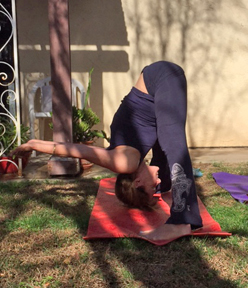 “Understanding the Range of Motion in Our Bodies” “Our goal in life is not to become perfect; Our goal is to become whole.” As we practice yoga, whether it be a dynamic vinyasa practice of engaging yang tissues (muscular) or working the deeper yin tissues (fascia) we need to pay attention to what we are feeling. In Yin Yoga we are holding our poses 3 to 5 minutes, targeting connective tissues, ligaments and bones. It is important to remember that muscular yang tissue have networks of yin fascia tissues deep within the muscle. A way of understanding this is to look at the Yin/Yang symbol. Notice how the light is swirling in the dark and the dark is swirling in the light. Muscles are considered yang, yet have 30% yin tissues within the muscle. The 30% which is yin is actually fascia tissue that need fluids to stay moist and flexible. Yin tissues are drier and much less elastic, especially as we age. When we hold our poses we bring moisture and nourishment to our tissues which increases the Synovial fluid (a lubricating fluid resembling the white of an egg, secreted by certain membranes to keep our joints working properly) Yin yoga helps to rebuild the synovial joints/fluids. It extends the current range of motion which help us to remain mobile and flexible. That said, we realize that it is the fascia tissue within our muscle cells that create strength. Power yoga is great for developing our strength within our muscle, yet it is the yin part of our practice that creates the length and flexibly. 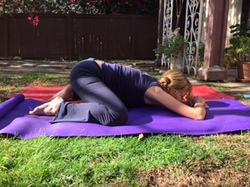 Yin is specifically designed to exercise the ligaments and to regain space and strength in the joints. There are three kinds of joints; 1. Fibrous joints, bones held together by connective tissues 2. Cartilaginous joints, where the bones are held together by cartilage and allow slight movement and 3. Synovial joints, the space between the bones. The Synovial joint allows the greatest degree of movement. These joints can be seen as spaces between the bones where movement is possible. The limits of flexibility include stretching the tissues, compressing the tissues and shearing them which we do in all twisting poses. As a student of yoga you are your best teacher! Ask yourself what stops me from going deeper in my pose. Experts agree that limitation on our flexibility is due to tension along the tissues which resists further elongation. Two things most experts agree on is “If tension is stopping the movement, it is felt in the direction away from the movement. If compression is stopping the movement it is felt in the direction of the movement.” The range of motion in our joints, is limited by tension. However our ROM can be increased through yoga asanas, breath and diet. When you have reach ROM in your pose, that may be as far as you can go at this point. You may be able to do another pose and go around the point of compression. Although after you have worked through all of your resistance, it is compression that stops you. In Yin our blood and lymphatic fluids are like “warm water” to our meridians. When they become clogged we can remove these deep blockages as we bend, stretch and breath. This is especially true in a Yin Yoga practice! |
Adriana RuaneAdriana has been practicing and living yoga most of her life. She currently teaches at Sedona Hot Yoga, 7 Centers Yoga Arts, and Aumbase in Sedona Arizona as well as private instruction in her home and on location. Archives
March 2021
Categories |
| AdrianaYogi |
|

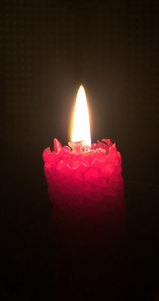
 RSS Feed
RSS Feed
